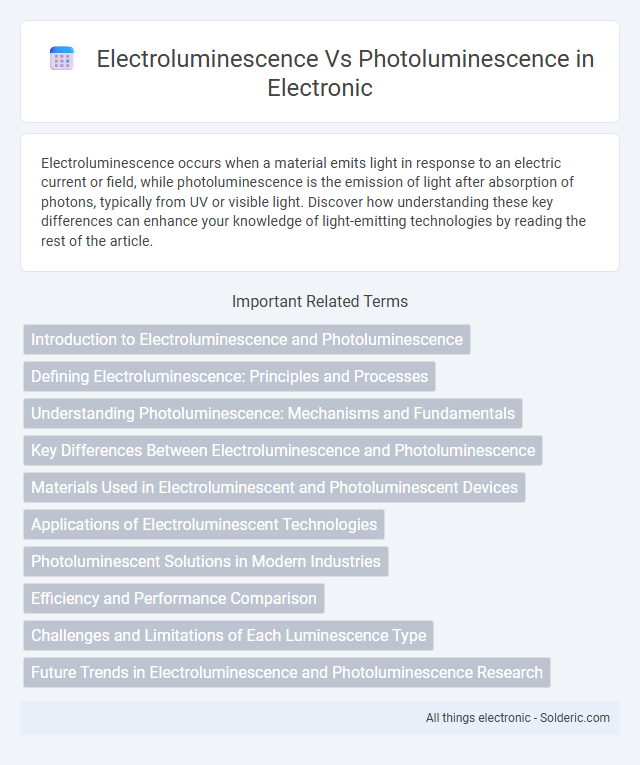Electroluminescence occurs when a material emits light in response to an electric current or field, while photoluminescence is the emission of light after absorption of photons, typically from UV or visible light. Discover how understanding these key differences can enhance your knowledge of light-emitting technologies by reading the rest of the article.
Comparison Table
| Feature | Electroluminescence (EL) | Photoluminescence (PL) |
|---|---|---|
| Definition | Light emission from a material due to an electric current or field. | Light emission from a material after absorbing photons. |
| Excitation Source | Electric current or voltage applied. | Optical (photon) excitation. |
| Application | OLEDs, LED displays, electroluminescent panels. | Material characterization, LEDs testing, solar cells research. |
| Emission Duration | Continuous as long as electric current is applied. | Afterglow decays after excitation stops. |
| Spectral Range | Dependent on material and device design. | Intrinsic to material's electronic structure. |
| Measurement Technique | Electroluminescence spectroscopy. | Photoluminescence spectroscopy. |
Introduction to Electroluminescence and Photoluminescence
Electroluminescence is the phenomenon where materials emit light in response to an electric current or a strong electric field, commonly utilized in LED technology and OLED displays for efficient light generation. Photoluminescence occurs when materials absorb photons and re-emit them as visible light, playing a critical role in applications like fluorescence imaging and optical sensors. Understanding these light-emission mechanisms enhances your ability to select appropriate materials for electronic and photonic devices.
Defining Electroluminescence: Principles and Processes
Electroluminescence (EL) is the phenomenon where materials emit light in response to an electric current or field, occurring when electrons recombine with holes in a semiconductor, releasing energy as photons. This process involves charge injection, transport, and recombination within devices such as organic LEDs (OLEDs) or inorganic LEDs. Understanding these principles helps you optimize device efficiency and tailor emission properties for applications in displays and lighting.
Understanding Photoluminescence: Mechanisms and Fundamentals
Photoluminescence is a process where materials absorb photons and re-emit them after a brief delay, driven by electronic transitions within atoms or molecules. This phenomenon involves excitation of electrons to higher energy states, followed by radiative relaxation back to their ground state, releasing light. Key mechanisms include fluorescence, where emission occurs almost instantaneously, and phosphorescence, characterized by delayed emission due to spin-forbidden transitions.
Key Differences Between Electroluminescence and Photoluminescence
Electroluminescence occurs when a material emits light in response to an electric current or electric field, while photoluminescence is the emission of light after the material absorbs photons. The key difference lies in the excitation source: electroluminescence is electrically driven, whereas photoluminescence relies on optical excitation. Understanding these distinctions can help you optimize materials for applications in LEDs, displays, and optical sensors.
Materials Used in Electroluminescent and Photoluminescent Devices
Electroluminescent devices typically use inorganic semiconductors such as gallium arsenide and organic compounds like conjugated polymers to emit light when an electric current passes through. Photoluminescent materials often include phosphors such as zinc sulfide doped with manganese or europium-doped strontium aluminate, which absorb photons and re-emit light upon excitation. The choice of materials in both phenomena directly influences emission efficiency, wavelength, and device durability.
Applications of Electroluminescent Technologies
Electroluminescent technologies are widely used in display screens, including OLED TVs and smartphone displays, due to their high brightness and energy efficiency. Their application in flexible lighting panels allows for innovative designs in automotive and architectural lighting, enhancing both aesthetics and functionality. You benefit from electroluminescent devices in wearable electronics, where thin, lightweight, and flexible light sources improve user experience and device performance.
Photoluminescent Solutions in Modern Industries
Photoluminescent solutions, widely utilized in safety signage, automotive lighting, and medical diagnostics, rely on materials that absorb photons and re-emit light without electrical input. Their energy-efficient, long-lasting properties make them integral in emergency exit indicators and wearable health monitors. Advances in nanophosphors and organic dyes enhance brightness and durability, driving innovation in sustainable, high-performance photoluminescent applications.
Efficiency and Performance Comparison
Electroluminescence offers higher efficiency in device applications due to direct electrical excitation, resulting in better performance for light-emitting diodes (LEDs) and display technologies. Photoluminescence efficiency depends on the material's ability to absorb and re-emit photons, often showing lower quantum yield compared to electroluminescent systems. The overall performance gap is significant in practical usage, where electroluminescent devices maintain stable output under continuous electrical driving conditions.
Challenges and Limitations of Each Luminescence Type
Electroluminescence faces challenges such as efficiency droop at high current densities and material degradation impacting device lifespan. Photoluminescence is limited by issues like low quantum yield in certain materials and quenching effects due to impurities or defects. Both techniques require optimized material design to overcome spectral instability and enhance emission intensity.
Future Trends in Electroluminescence and Photoluminescence Research
Future trends in electroluminescence research emphasize advancements in organic light-emitting diodes (OLEDs) and perovskite materials, aiming for higher efficiency, longer device lifetimes, and flexible display applications. Photoluminescence studies focus on novel quantum dot and 2D material systems to enhance emission properties for bioimaging, sensing, and solar energy conversion technologies. Integration of machine learning and nanofabrication techniques is accelerating the discovery of new materials with tailored luminescent properties, driving innovation across optoelectronic devices and photonic applications.
Electroluminescence vs Photoluminescence Infographic

 solderic.com
solderic.com